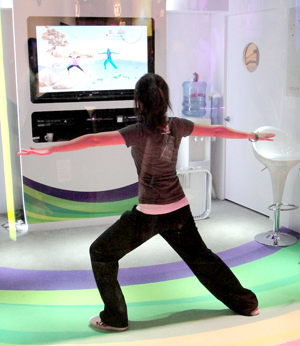 More than 70 percent of U.S. adolescents get less than the recommended 60 minutes of physical activity — such as walking or bicycling — each day. Recent studies also estimate that 60 percent of adolescents play two hours of video games daily. Low physical activity and high screen time seems like a combination for poor health, but what if they could be used together to get adolescents moving? A new study using School of Public Health data shows that encouraging adolescents to play physical activity video games could be the answer — especially for girls.
More than 70 percent of U.S. adolescents get less than the recommended 60 minutes of physical activity — such as walking or bicycling — each day. Recent studies also estimate that 60 percent of adolescents play two hours of video games daily. Low physical activity and high screen time seems like a combination for poor health, but what if they could be used together to get adolescents moving? A new study using School of Public Health data shows that encouraging adolescents to play physical activity video games could be the answer — especially for girls.
The study, a collaboration between the School of Public Health’s long-running Project EAT and School of Kinesiology Assistant Professor Daheia Barr-Anderson, was recently published in the Journal of Adolescent Health.
Physical activity video games — or “exergames” — require people to move their bodies in some way in order to play. Examples include the well-known Dance Dance Revolution and the more recent augmented reality game, Pokemon Go, where gamers search real-world locations to “catch” virtual characters.

Barr-Anderson’s study looked at the amount of overall physical activity reported by male and female adolescents who did and did not play exergames.
“The study showed that adolescent boys who participate in active video games did not report significantly greater physical activity than male non-exergamers,” says Barr-Anderson. “Interestingly, the results were different for female exergamers, who reported greater levels of vigorous physical activity than female non-exergamers.”
Barr-Anderson said the positive association between girls who spend more time being vigorously active and those who play exergames shows that the games may play a role in increasing vigorous activity or serve as a gateway to such activities. Adolescent girls tend to choose exergames that they enjoy, which may increase their motivation, lead to playing at a greater intensity, and possibly cross over to higher intensity activities.
“Introducing innovative strategies is key when trying to engage anyone in a positive behavior change,” says Barr-Anderson. “The incorporation of exergames to increase physical activity in girls is currently underutilized, but it could be an exciting, new way to increase this positive behavior, which has implications to increased fitness and reduced risk for some chronic diseases.”
Barr-Anderson is continuing her physical activity research, this time looking at the associations between yoga and various health behaviors and outcomes.
